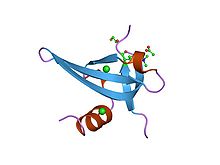- Chromodomain
-
Chromodomain 
Structure of polycomb chromodomain.[1] Identifiers Symbol Chromodomain Pfam PF00385 InterPro IPR000953 SMART SM00298 PROSITE PS50013 SCOP 1pfb CDD cd00024 Available protein structures: Pfam structures PDB RCSB PDB; PDBe PDBsum structure summary A chromodomain (chromatin organization modifier [2]) is a protein structural domain of about 40-50 amino acid residues commonly found in proteins associated with the remodeling and manipulation of chromatin. The domain is highly conserved among both plants and animals, and is represented in a large number of different proteins in many genomes, such as that of the mouse. Some chromodomain-containing genes have multiple alternative splicing isoforms that omit the chromodomain entirely.[3] In mammals, chromodomain-containing proteins are responsible for aspects of gene regulation related to chromatin remodeling and formation of heterochromatin regions.[4] Chromodomain-containing proteins also bind methylated histones[5][6] and appear in the RNA-induced transcriptional silencing complex.[7]
See also
References
- ^ Min J, Zhang Y, Xu RM (August 2003). "Structural basis for specific binding of Polycomb chromodomain to histone H3 methylated at Lys 27". Genes Dev. 17 (15): 1823–8. doi:10.1101/gad.269603. PMC 196225. PMID 12897052. http://www.pubmedcentral.nih.gov/articlerender.fcgi?tool=pmcentrez&artid=196225.
- ^ S Messmer, A Franke, R Paro (July 1992). "Analysis of the functional role of the Polycomb chromo domain in Drosophila melanogaster.". Genes Dev. 6 (7): 1241–1254. doi:10.1101/gad.6.7.1241. PMID 1628830.
- ^ Tajul-Arifin K, Teasdale R, Ravasi T, Humel DA, Group RIKEN GER, Members GSL, Mattick JS. (2003). "Identification and Analysis of Chromodomain-Containing Proteins Encoded in the Mouse Transcriptome". Genome Res 13 (6B): 1416–1429. doi:10.1101/gr.1015703. PMC 403676. PMID 12819141. http://www.pubmedcentral.nih.gov/articlerender.fcgi?tool=pmcentrez&artid=403676.
- ^ Jones DO, Cowell IG, Singh PB. (2000). "Mammalian chromodomain proteins: their role in genome organisation and expression". Bioessays 22 (2): 124–37. doi:10.1002/(SICI)1521-1878(200002)22:2<124::AID-BIES4>3.0.CO;2-E. PMID 10655032.
- ^ Nielsen PR, Nietlispach D, Mott HR, Callaghan J, Bannister A, Kouzarides T, Murzin AG, Murzina NV et al. (2002). "Structure of the HP1 chromodomain bound to histone H3 methylated at lysine 9". Nature 416 (6876): 103–7. doi:10.1038/nature722. PMID 11882902.
- ^ Jacobs SA, Khorasanizadeh S. (2002). "Structure of HP1 chromodomain bound to a lysine 9-methylated histone H3 tail". Science 295 (5562): 2080–3. doi:10.1126/science.1069473. PMID 11859155.
- ^ Verdel A, Jia S, Gerber S, Sugiyama T, Gygi S, Grewal S, Moazed D (2004). "RNAi-mediated targeting of heterochromatin by the RITS complex". Science 303 (5658): 672–6. doi:10.1126/science.1093686. PMID 14704433.
External links

This protein-related article is a stub. You can help Wikipedia by expanding it.
